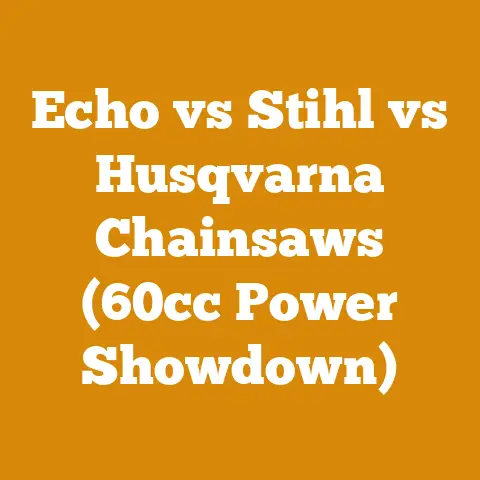How to Identify Hickory Firewood (5 Essential Woodworker Tips)
Imagine this: It’s a crisp autumn evening, the kind where the air bites with a promise of winter.
Inside, a fire crackles merrily in the hearth, casting a warm, amber glow across the room.
The scent is intoxicating – not the acrid burn of pine, but a rich, almost sweet aroma that speaks of slow-burning energy.
That’s hickory, my friends, at its finest.
Now picture this instead: You’ve just wrestled a load of firewood into the shed, back aching, only to find it burns hot and fast, leaving behind a mountain of ash and offering little sustained heat.
The aroma is…well, it’s just wood smoke.
Disappointment sets in.
You thought you were getting a good deal, but you were sold something less than desirable.
The difference?
Knowing your wood.
Specifically, knowing how to identify hickory firewood.
As someone who’s spent years felling trees, milling lumber, and preparing firewood, I can tell you that identifying hickory is a crucial skill for anyone serious about wood heat or woodworking.
It’s not just about avoiding a bad purchase; it’s about understanding the unique properties of this incredible wood and harnessing its potential.
In this guide, I’m going to share my hard-earned knowledge, gleaned from countless hours in the woods and around the fire, to help you become a hickory identification expert.
How to Identify Hickory Firewood (5 Essential Woodworker Tips)
Hickory firewood is prized for its high heat output, long burn time, and distinctive aroma.
But with several hickory species and look-alike woods, it can be tricky to identify.
These five tips will help you confidently identify hickory, ensuring you get the most out of your firewood or woodworking projects.
1. Bark Characteristics: Reading the Tree’s Skin
The bark is often the first clue to a tree’s identity.
While bark can vary depending on the tree’s age and growing conditions, certain characteristics are distinctly hickory.
Shagbark Hickory ( Carya ovata ): This is perhaps the easiest hickory to identify.
As the name suggests, its bark is shaggy, peeling off in long, thick plates that are loose at both ends.
These plates can be several inches wide and a foot or more in length.
The color is typically a light to medium gray.
I’ve personally seen shagbark hickories with bark plates so loose they nearly fall off with a gentle tug.
One time, I even used a large piece of shagbark as a makeshift tinderbox during a camping trip – it worked surprisingly well!Mockernut Hickory ( Carya tomentosa ): Mockernut hickory bark is deeply furrowed and ridged, forming a diamond-shaped pattern.
The ridges are typically tight and do not peel off like shagbark.
The bark is a darker gray than shagbark.
I remember once misidentifying a mockernut as an oak from a distance because the bark pattern was similar.
A closer inspection revealed the subtle differences in texture and color.Pignut Hickory ( Carya glabra ): Pignut hickory bark is generally smoother than shagbark or mockernut, especially on younger trees.
On older trees, it may develop shallow furrows and ridges.
The ridges are typically tight and close together.
The color is often a brownish-gray.
I’ve found pignut hickory to be the most challenging to identify based on bark alone, as it can resemble ash or even some maples.Bitternut Hickory ( Carya cordiformis ): Bitternut hickory has relatively smooth bark, even on older trees.
The bark is usually tight and has shallow fissures.
A key identifier is the presence of bright yellow buds during the dormant season.
These buds are elongated and pointed, unlike the rounded buds of other hickories.
I once used the presence of these yellow buds to confirm the identity of a bitternut hickory growing near a stream, even though the bark was somewhat ambiguous.
Important Note: Bark identification is best used in conjunction with other characteristics.
Don’t rely solely on bark, especially if you’re a beginner.
My Experience: I’ve learned to “read” bark over years of experience.
It’s like learning a new language.
Each species has its own dialect, and with practice, you can become fluent.
However, always remember that bark can vary depending on the tree’s environment.
A hickory growing in a dense forest will have different bark than one growing in an open field.
2. Leaf and Bud Characteristics: A Closer Look at the Foliage
Hickory leaves are compound, meaning they consist of multiple leaflets attached to a single stem.
The number, shape, and texture of these leaflets are key to identification.
Shagbark Hickory: Typically has 5 leaflets, although sometimes there can be 7.
The terminal leaflet (the one at the end) is usually larger than the others.
The leaflets are ovate to lanceolate (egg-shaped to lance-shaped) and have serrated (toothed) edges.
The underside of the leaflets is usually hairy.Mockernut Hickory: Usually has 7-9 leaflets.
The leaflets are broadly lanceolate and have serrated edges.
The underside of the leaflets is densely hairy, giving them a velvety texture.
This is a key distinguishing feature of mockernut hickory.Pignut Hickory: Typically has 5-7 leaflets.
The leaflets are lanceolate to oblanceolate (lance-shaped to inversely lance-shaped) and have serrated edges.
The underside of the leaflets is usually smooth or only slightly hairy.Bitternut Hickory: Has 7-11 leaflets, the most of any common hickory.
The leaflets are lanceolate and have finely serrated edges.
The leaflets are usually smooth and hairless.
The terminal buds are distinctive – long, slender, and yellowish-brown.
Leaf Measurement: To get a more precise understanding, consider measuring the leaflets.
For example, a mature shagbark hickory leaflet might be 6-8 inches long and 3-4 inches wide.
A mockernut leaflet could be slightly smaller, perhaps 4-6 inches long and 2-3 inches wide.
These measurements are approximate, but they can help you differentiate between species.
Bud Examination: Hickory buds can also be helpful in identification, especially during the dormant season.
As mentioned earlier, bitternut hickory has distinctive yellow buds.
Shagbark hickory buds are large, hairy, and brown.
Mockernut hickory buds are also hairy, but they are generally smaller than shagbark buds.
Pignut hickory buds are relatively small and smooth.
My Experience: I once spent an afternoon keying out different hickory species using a botanical guide and a magnifying glass.
It was a tedious process, but it taught me the importance of paying attention to detail.
I learned to appreciate the subtle differences in leaf shape, texture, and venation.
3. Nut and Husk Characteristics: The Fruitful Evidence
Hickory nuts are enclosed in a husk, which splits open when the nut is ripe.
The size, shape, and thickness of the husk, as well as the size and taste of the nut, are important identification features.
Shagbark Hickory: Produces a large, nearly spherical nut that is enclosed in a thick, four-sectioned husk.
The husk is typically dark brown and splits open completely when the nut is ripe.
The nut is sweet and edible, highly prized by wildlife and humans alike.
I’ve harvested shagbark hickory nuts for years, and they are a delicious and nutritious treat.Mockernut Hickory: Produces a smaller, more oblong nut than shagbark hickory.
The husk is thick and four-sectioned, but it does not always split open completely.
The nut is edible, but it is not as sweet as shagbark hickory.
The “mockernut” name comes from the thick husk and relatively small nut inside.Pignut Hickory: Produces a small, pear-shaped nut that is enclosed in a thin husk.
The husk splits open partially or not at all.
The nut is often bitter and unpalatable, hence the name “pignut.” I’ve tasted pignut hickory nuts before, and I can confirm that they are not something you’d want to snack on.Bitternut Hickory: Produces a small, thin-shelled nut that is enclosed in a thin, winged husk.
The husk splits open along four seams.
The nut is extremely bitter and inedible.
As the name suggests, it’s incredibly bitter.
Nut Size Comparison: A shagbark hickory nut might be 1.5-2 inches in diameter, while a pignut hickory nut might only be 1 inch in diameter.
These differences in size can be significant when trying to identify a tree.
My Experience: One fall, I was hiking in the woods and came across a pile of hickory nuts that had been cached by a squirrel.
By examining the nuts and husks, I was able to determine that they were a mix of shagbark and mockernut hickory.
It was a fascinating glimpse into the workings of nature.
4. Wood Grain and Density: The Heart of the Matter
Once the tree is felled and cut into firewood, the wood grain and density become important identification factors.
Hickory is known for its strength, hardness, and distinctive grain.
Grain Pattern: Hickory has a close, interlocked grain pattern.
This means that the wood fibers run in different directions, making it exceptionally strong and resistant to splitting.
The grain is usually visible and distinct.Density: Hickory is a very dense wood, meaning it is heavy for its size.
This density contributes to its high heat output when burned.
A cubic foot of dry hickory weighs approximately 50-55 pounds.Color: Hickory heartwood is typically a light to medium brown, while the sapwood is a creamy white.
The color can vary depending on the species and growing conditions.
The “Weight Test”: One simple way to assess density is to compare the weight of a piece of hickory firewood to a piece of another species of similar size.
Hickory will almost always feel heavier.
For instance, a 16-inch long piece of hickory firewood with a 6-inch diameter will weigh significantly more than a similar-sized piece of pine or poplar.
Splitting Characteristics: Hickory can be challenging to split, especially if it is knotty or has interlocked grain.
This is due to its density and strength.
However, once split, it burns cleanly and efficiently.
I often use a hydraulic log splitter when processing hickory, as it makes the job much easier.
For example, a good hydraulic splitter with a 25-ton capacity can easily handle even the most challenging hickory rounds.
My Experience: I once built a workbench entirely out of hickory.
The wood was incredibly hard to work with, requiring sharp tools and a lot of patience.
But the end result was a rock-solid, durable workbench that will last for generations.
That project taught me a deep respect for the strength and resilience of hickory.
5. The Burn Test: The Ultimate Confirmation
The final test is to burn a small piece of the wood and observe its burning characteristics.
Hickory has a distinctive aroma and burns with a hot, steady flame.
Aroma: Hickory has a sweet, pungent aroma when burned.
It’s a pleasant and distinctive smell that is easily recognizable once you’ve experienced it.
This is often described as a smoky, bacon-like scent.Flame Characteristics: Hickory burns with a hot, bright flame.
It produces very little smoke, especially when properly seasoned.
The flames are usually steady and consistent.Heat Output: Hickory has one of the highest heat outputs of any hardwood.
It produces approximately 27.7 million BTUs per cord.
This is significantly higher than other common firewood species like oak (24 million BTUs per cord) or maple (20 million BTUs per cord).Coaling: Hickory coals well, meaning it forms a bed of hot embers that radiate heat for a long time.
This is one of the reasons why hickory is such a desirable firewood.
Seasoning is Key: Remember that the burning characteristics of hickory will vary depending on its moisture content.
Green (unseasoned) hickory will smoke excessively and burn inefficiently.
Properly seasoned hickory should have a moisture content of 20% or less.
I use a moisture meter to ensure that my firewood is properly seasoned before burning it.
For example, a good moisture meter like the General Tools MMD4E can accurately measure the moisture content of firewood.
My Experience: I’ve spent many evenings sitting by a hickory fire, enjoying its warmth and aroma.
There’s something deeply satisfying about knowing that you’re burning a wood that you’ve identified yourself, harvested responsibly, and seasoned properly.
It’s a connection to nature that is hard to describe.
Case Study: Identifying Hickory in a Mixed Hardwood Stand
Let’s walk through a real-world scenario.
I was recently asked to assess a stand of mixed hardwoods on a friend’s property.
He wanted to know which trees were suitable for firewood and which were better suited for lumber.
Step 1: Initial Assessment: I started by walking through the stand and visually identifying the dominant tree species.
I noticed a mix of oak, maple, ash, and what appeared to be hickory.
Step 2: Bark Examination: I focused on the trees that I suspected were hickory.
Some had shaggy bark, clearly indicating shagbark hickory.
Others had deeply furrowed bark, suggesting mockernut hickory.
A few had relatively smooth bark, which could have been pignut or bitternut hickory.
Step 3: Leaf and Bud Examination: I collected leaf samples from each of the suspected hickory trees.
I compared the number, shape, and texture of the leaflets to my field guide.
I also examined the buds, noting their size, shape, and color.
This helped me differentiate between pignut and bitternut hickory.
Step 4: Nut and Husk Examination: Luckily, it was fall, and there were some nuts and husks on the ground.
By examining these, I was able to confirm my identification of shagbark, mockernut, pignut, and bitternut hickory.
Step 5: Wood Examination (Felled Trees): We felled a few of the trees that were damaged or diseased.
I examined the wood grain and density.
The hickory wood was noticeably heavier and had a more interlocked grain than the other species.
Step 6: Burn Test (Sample): Finally, I took a small sample of the hickory wood and burned it in my wood stove.
The aroma was distinctive, and the wood burned with a hot, steady flame.
Conclusion: Based on my assessment, I recommended that my friend harvest the shagbark and mockernut hickory for firewood, as they are the most desirable species for burning.
I suggested that he mill the oak and ash for lumber, as they are better suited for woodworking projects.
Strategic Advantages of Using Hickory Firewood
Choosing hickory firewood offers several strategic advantages:
-
High Heat Output: Hickory provides more heat per cord than most other firewood species, reducing the amount of wood you need to burn.
-
Long Burn Time: Hickory burns slowly and steadily, providing consistent heat for extended periods.
-
Excellent Coaling: Hickory forms a bed of hot embers that radiate heat long after the flames have died down.
-
Distinctive Aroma: Hickory has a pleasant and recognizable aroma that enhances the ambiance of a fire.
-
Sustainable Resource: When harvested responsibly, hickory is a sustainable resource that can provide heat for generations.
Cost-Benefit Analysis: While hickory firewood may be slightly more expensive than other species, its higher heat output and longer burn time can make it a more cost-effective choice in the long run.
Consider the cost per BTU (British Thermal Unit) when comparing different firewood options.
For example, if hickory costs $300 per cord and provides 27.7 million BTUs, the cost per BTU is approximately $0.0000108.
If oak costs $250 per cord and provides 24 million BTUs, the cost per BTU is approximately $0.0000104.
In this case, oak is slightly cheaper per BTU, but the difference is minimal.
The other advantages of hickory, such as its longer burn time and better coaling, may outweigh the slight cost difference.
Safety Considerations When Handling Hickory
Working with hickory, like any wood, requires careful attention to safety:
-
Personal Protective Equipment (PPE): Always wear appropriate PPE, including safety glasses, hearing protection, gloves, and sturdy boots.
Chainsaw Safety: If you are felling trees or cutting firewood, follow all chainsaw safety guidelines.
This includes wearing a helmet with a face shield, chaps, and gloves.Log Splitting Safety: When splitting logs, use a hydraulic log splitter or a splitting axe with caution.
Keep your hands clear of the splitting area.Lifting Techniques: Use proper lifting techniques to avoid back injuries.
Bend your knees and keep your back straight.-
Storage: Store firewood in a dry, well-ventilated area to prevent rot and insect infestation.
Carbon Monoxide Safety: Ensure that your wood stove or fireplace is properly vented to prevent carbon monoxide poisoning.
Install a carbon monoxide detector in your home.
Example: Safe Chainsaw Operation: Before starting a chainsaw, always inspect it for any damage or loose parts.
Make sure the chain is properly tensioned and lubricated.
When cutting, maintain a firm grip on the saw and keep your body balanced.
Never cut above your shoulder height or reach excessively.
Use a wedge to prevent the saw from pinching in the cut.
Next Steps: Putting Your Hickory Knowledge to Use
Now that you’ve learned how to identify hickory firewood, it’s time to put your knowledge into practice.
Here are some next steps you can take:
- Practice Identification: Go for a walk in the woods and try to identify different hickory species based on their bark, leaves, and nuts.
- Source Hickory Firewood: Contact local firewood suppliers and ask if they sell hickory.
Inspect the wood carefully before you buy it. - Harvest Your Own Hickory: If you have access to hickory trees, consider harvesting your own firewood.
Be sure to obtain any necessary permits and follow sustainable harvesting practices. - Season Your Firewood: Properly season your firewood by stacking it in a dry, well-ventilated area for at least six months.
- Enjoy the Warmth: Build a fire with your hickory firewood and enjoy its warmth, aroma, and long-lasting heat.
Final Thoughts: Identifying hickory firewood is a valuable skill that can enhance your enjoyment of wood heat and your appreciation for the natural world.
By learning to recognize the unique characteristics of hickory, you can ensure that you are getting the most out of this exceptional wood.
So, get out there, explore the woods, and start identifying hickory!
You’ll be surprised at how rewarding it can be.
Remember my initial story?
Now, you can ensure you’re the one enjoying that warm, hickory-scented evening, rather than wrestling with a disappointing pile of inferior wood.
Happy burning!






